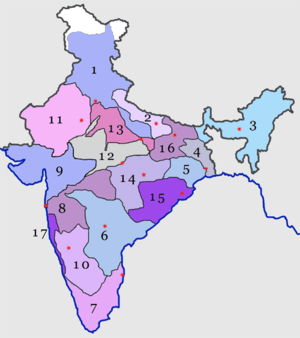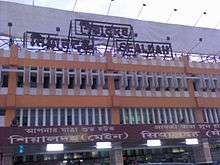Eastern Railway zone
 4-Eastern Railway | |
 | |
| Locale | West Bengal and Jharkhand |
|---|---|
| Dates of operation | April 14, 1952– |
| Predecessor | East Indian Railway |
| Track gauge | Mixed |
| Length | 2,680 kilometres (1,670 mi) |
| Headquarters | Fairley Place, Kolkata |
| Website | ER official website |
The Eastern Railway (ER) is one of the largest and High-Tech Zone in Indian Railways, it is among the 16 zones of the Indian Railways. Its headquarters is at Fairley Place, Kolkata and comprises four divisions: Howrah, Malda, Sealdah, and Asansol. Each division is headed by a Divisional Railway Manager (DRM). The name of the division denotes the name of the city where the divisional headquarters is located. Eastern Railway Consists Most no. of A1 and A Category Stations like Howrah, Sealdah, Asansol, Durgapur etc. Eastern Railways operates one of the oldest trains of India, Kalka Mail. 3 Popular Zones ECR, SER and NFR were part of ER before.
It has three major workshops: Jamalpur, Liluah, and Kanchrapara. The Jamalpur Workshop is for wagon repair, periodic overhaul (POH) of diesel locomotives, manufacturing of cranes and tower-wagons; the Liluah workshop is for POH of coaching & freight vehicles and the Kanchrapara workshop is for POH of electric locomotives, EMU Locals and coaches.
History
The East Indian Railway (EIR) Company was incorporated in 1845 to connect East India with Delhi. The first train ran here between Howrah and Hooghly on 15 August 1854. The train left Howrah Station at 8:30 a.m. and reached Hooghly in 91 minutes. The management of the East Indian Railway was taken over by the British Indian government on 1 January 1925.[1]
The Eastern Railway was formed on 14 April 1952 by amalgamating three lower divisions of the East Indian Railway: Howrah, Asansol and Danapur, the entire Bengal Nagpur Railway (BNR) and the Sealdah division of the erstwhile Bengal Assam Railway[2] (which was already added to the East Indian Railway on 15 August 1947). On 1 August 1955, the portions of BNR stretching from Howrah to Visakhapatnam in the South, Howrah to Nagpur in the Central area and up to Katni in the North Central Region were separated from Eastern Railway and became the South Eastern Railway.[3][4] Three more divisions: Dhanbad, Mughalsarai and Malda were formed later.[5] Till 30 September 2002 ER consisted seven divisions. On 1 October 2002 a new zone, the East Central Railway, headquarters at Hajipur, was carved out by separating the Eastern Railway's Danapur, Dhanbad and Mughalsarai divisions from it.[4] Presently, it comprises five divisions.
Routes


Trunk routes
Other sections
- Howrah-Bardhaman Main Line of Howrah-Delhi main line
- Bandel-Katwa
- Sheoraphuli – Tarakeswar – Arambagh Branch Line
- Howrah-Bardhaman Chord of Howrah-Delhi main line
- Barharwa-Azimganj-Khagraghat Road-Katwa Loop Line
- Jasidih Dumka Rampurhat Rail line
- Bardhaman-Asansol section of Howrah-Delhi main line
- Khana-Barharwa section of Sahibganj Loop
- Lalgola and Gede branch lines
- Andal-Sainthia Branch Line
- Sealdah-Ranaghat Line
- Lalgola and Gede branch lines
- Ranaghat - Shantipur - Krishnanagar City
- Howrah-Belur Math
- Sealdah-Barasat-Bangaon-Ranaghat Line
- Barasat - Hasnabad Branch Single Line
- Dum Dum - Biman Bandar
- Sealdah - Baruipur - Diamond Harbour of Sealdah South Lines
- Sonarpur - Canning of Sealdah South Lines
- Baruipur - Lakshmikantapur - Namkhana of Sealdah South Lines
- Sealdah - Budge Budge of Sealdah South Lines
- Kolkata Circular Railway
- Ahmedpur Katwa Railway
- Burdwan Katwa Railway
References
- ↑ Rao, M.A. (1988). Indian Railways, New Delhi: National Book Trust, pp.13,34
- ↑ "Sealdah division-Engineering details". The Eastern Railway, Sealdah division.
- ↑ Rao, M.A. (1988). Indian Railways, New Delhi: National Book Trust, pp.42–3
- 1 2 "The Eastern Railway-About us". The Eastern Railway.
- ↑ "Focus-Eastern Railway". Press Information Bureau, Government of India.